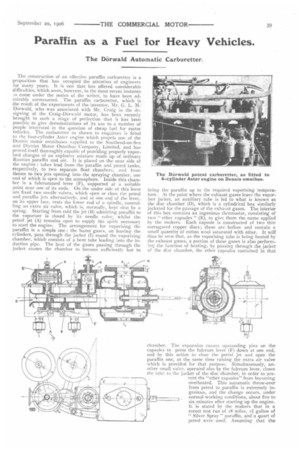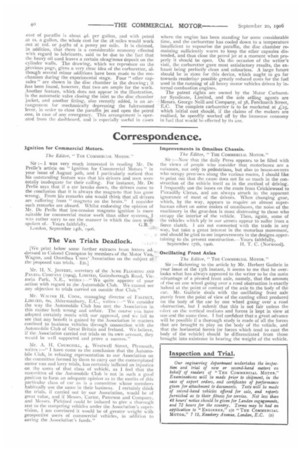Paraffin as a Fuel for Heavy Vehicles.
Page 15

Page 16

If you've noticed an error in this article please click here to report it so we can fix it.
The Dorwald Automatic Carburetter.
The construction of an effective paraffin carburetter is a proposition that has occupied the attention of engineers for many years. It is one that has offered considerable difficulties, which seem, however, in the most recent instance to come under the notice of the writer, to have been admirably surmounted. The paraffin carburetter, which is the result of the experiments of the inventor, Mr. G. L. M. Dorwald, who was associated with Mr. Craig in the designing of the Craig-Dorwald motor, has been recently brought to such a stage of perfection that it has been possible to give demonstrations of its use to a number of people interested in the question of cheap fuel for motor vehicles. The carburetter as shown to enquirers is fitted to the four-cylinder Aster engine which propels one of the Dennis motor omnibuses sJpplied to the Southend-on-Sea and District Motor Omnibus Company, Limited, and has proved itself thoroughly capable of providing properly vaporised charges of an explosive mixture made up of ordinary Russian paraffin and air. It is placed on the near side of the engine : tubes lead from the paraffin and petrol tanks, respectively, to two separate float chambers, and from thence to two jets opening into the spraying chamber, one end of which is open to the atmosphere. Inside this chamber is a fulcrummed lever (F), supported at a suitable point near one of its ends. On the under side of this lever are fixed two needle valves, which open or close the petrol and paraffin jets alternatively, and at one end of the lever, on its upper face, rests the lower end of a spindle, controlling an extra air valve, which is, normally, kept shut by a spring. Starting from cold the jet (B) admitting paraffin to the vaporiser is closed by its needle valve, whilst the petrol jet (A) remains open to supply the spirit necessary to start the engine. The arrangement for vaporising the paraffin is a simple one : the burnt gases, on leaving the cylinders, pass through the jacket (I) round the vaporising chamber, which consists of a bent tube leading into the induction pipe. The heat of the gases passing through the jacket causes the chamber to become sufficiently hot to bring the paraffin up to the required vaporising temperature. At the point where the exhaust gases leave the vaporiser jacket, an auxiliary tube is led to what is known as. the disc chamber (D), which is a cylindrical box similarly jacketed for the passage of the exhaust gases. The interior of this box contains an ingenious thermostat, consisting of two "ether capsules " (E), to give them the name applied by the makers. Each capsule is constructed of two thin corrugated copper discs ; these are hollow and contain a small quantity of cotton wool saturated with ether. It wilt thus be seen that, as the vaporising tube is being heated by the exhaust gases, a portion of these gases is also performing the function of heating, by passing through the jacket of the disc chamber, the ether capsules contained in that chamber. The expansion causes upstanding pins on the capsules to press the fulcrum lever (F) down at one end, and by this action to close the petrol jet and open the paraffin one, at the same time raising the extra air valve which is provided for that purpose. Simultaneously, another small valve, operated also by the fulcrum lever, closes the inlet to the jacket of the disc chamber, in order to pre vent the "ether capsules" from becoming overheated. This automatic throw-over from petrol to paraffin is extremely ingenious, and the change occurs, under normal working conditions, about five to six minutes after starting up the engine. It is stated by the makers that in a recent Lest run of tg miles, I/ gallon of " Silver Spray " paraffin, and a quart of petrol were used. Assuming that the
cost of paraffin is about 4d. per gallon, and with petrol at is. a gallon, the whole cost for the i8 miles would work out at rod. or 5-9ths of a penny per mile. It is claimed, in addition, that there is a considerable economy effected with regard to lubricants, said to be due to the fact that the heavy oil used leaves a certain oleaginous deposit on the cylinder walls. The drawing, which we reproduce on the previous page, gives a very clear idea of the carburetter, although several minor additions have been made to the mechanism during the experimental stage. Four "ether capsules" are shown in the disc chamber in the drawing; it has been found, however, that two are ample for the work. Another feature, which does not appear in the illustration, is the automatic valve closing the inlet to the disc chamber jacket, and another fitting, also recently added, is an arrangement for mechanically depressing the fulcrummed lever, in order to close the paraffin jet and open the petrol one, in case of any emergency. This arrangement is operated from the dashboard, and is especially useful in cases where the engine has been standing for sonic considerable time, and the carburetter has cooled down to a temperature insufficient to vapourise the paraffin, the disc chamber remaining sufficiently warm to keep the ether capsules distended, and thus close the petrol jet at a moment when properly it should be open. On the occasion of the writer's visit, the carburetter gave most satisfactory results, Lhe exhaust being perfectly clean and colourless. A large future should be in store for this device, which ought to go far towards renderinepossible greatly reduced costs for the fuel used in the running of all heavy motor vehicles driven by internal combustion engines.
The patent rights are owned by the Motor Carburetter Syndicate, Limited, and the sole selling agents are Messrs. George Neill and Company, of 38, Fenchurch Street, The complete carburetter is to be marketed at A;25, which initial cost should, if the claims of the makers are realised, be speedily worked off by the immense economy in fuel that would be effected by its use.
























